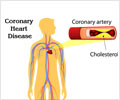
"People should be aware that their cholesterol and triglyceride levels vary significantly year-round, which in some cases, may lead to a misinterpretation of a person's actual cardiovascular risk," Filipe Moura, MD, a PhD student at the State University of Campinas, Brazil and the study's lead investigator said.
"This should especially concern those who are near the upper cholesterol limit as they may be at higher risk than expected. This is not to say these patients should have check-ups all the time, but we do have to keep a close eye on them and know seasonal variation may play a role," he said.
Researchers prospectively evaluated the lipid profiles of 227,359 individuals who had health check-ups in primary care centers in the city of Campinas, Brazil, between 2008 and 2010.
In this analysis-the largest study to date to evaluate cholesterol levels by season-data reveal that low density lipoprotein (LDL) or "bad" cholesterol increased an average of 7mg/dL during the winter compared to summer.
Researchers said that this moderate, but significant, increase in LDL cholesterol was enough to result in an 8 percent overall increase in the prevalence of high cholesterol during the winter.
Advertisement
Cholesterol levels during the summer months painted a very different picture, with higher levels of high density lipoprotein (HDL), the "good" cholesterol, and triglycerides, which were respectively 9 percent and 5 percent more prevalent.
Advertisement
For example, people tend to exercise less and consume a greater number of calories and fatty foods in the winter.
The shorter days of winter also mean less sun exposure and subsequently lower concentrations of vitamin D. Vitamin D has been shown to improve the ratio of bad to good cholesterol.
Source-ANI















